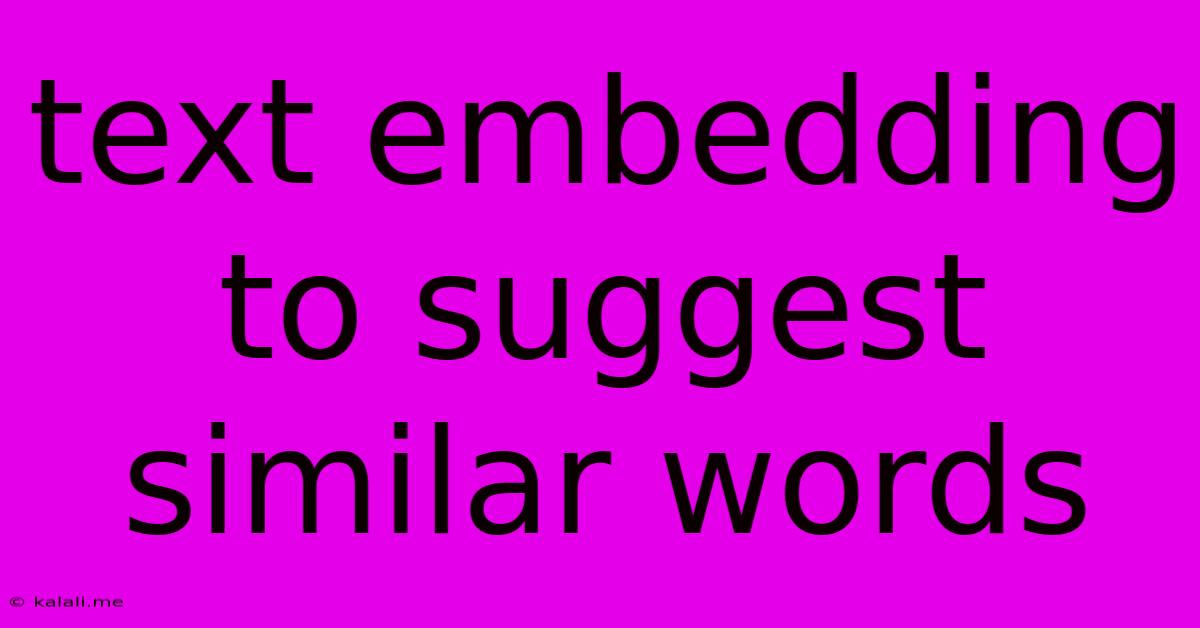Text Embedding To Suggest Similar Words
Kalali
May 25, 2025 · 4 min read

Table of Contents
Text Embedding: Unveiling the Power of Semantic Similarity for Word Suggestions
Meta Description: Discover how text embedding revolutionizes word suggestion tools. Learn about its underlying mechanisms, benefits, and applications in enhancing user experience and content creation. This comprehensive guide explores different embedding techniques and their impact on semantic similarity.
Finding the perfect word can be a frustrating task. Whether you're crafting compelling blog posts, writing creative fiction, or simply composing an email, the right word can dramatically impact the impact of your message. This is where text embedding comes into play, offering a powerful way to suggest semantically similar words, going beyond simple keyword matching.
This article delves into the fascinating world of text embedding and its application in suggesting similar words. We'll explore how it works, its advantages over traditional methods, and the different techniques involved.
What are Text Embeddings?
Text embeddings are numerical representations of words, phrases, or sentences. Imagine each word as a point in a high-dimensional space. Words with similar meanings are clustered closer together, while dissimilar words are farther apart. This spatial arrangement captures the semantic relationships between words, allowing algorithms to understand context and meaning.
Instead of relying solely on surface-level similarities (like words sharing common prefixes or suffixes), text embeddings capture the essence of a word's meaning within its broader context. This is crucial for generating relevant and nuanced word suggestions.
How Text Embedding Works for Word Suggestion
The process involves several key steps:
-
Training a Model: Sophisticated models, often based on deep learning architectures like Word2Vec, GloVe, or FastText, are trained on massive text corpora. This training process learns the relationships between words by analyzing their co-occurrence patterns within sentences and paragraphs.
-
Generating Embeddings: Once trained, the model can generate a vector (a numerical representation) for any given word. This vector encodes the word's semantic meaning.
-
Calculating Similarity: When a user seeks similar words, the model generates the embedding for the input word. Then, it compares this embedding to the embeddings of all other words in its vocabulary, using techniques like cosine similarity to measure how close they are in the high-dimensional space.
-
Suggesting Similar Words: The words with the highest similarity scores are presented as suggestions to the user. These suggestions are not simply synonyms; they encompass words with related meanings, even if they aren't direct synonyms.
Advantages of Using Text Embeddings for Word Suggestions
-
Semantic Understanding: Unlike simple keyword matching, text embeddings understand the nuances of meaning, offering more relevant and contextually appropriate suggestions.
-
Improved Accuracy: The ability to capture semantic relationships leads to significantly more accurate and helpful word suggestions.
-
Handling Polysemy: Text embeddings can handle words with multiple meanings (polysemy) by considering the surrounding context.
-
Discovering Unexpected Connections: They can uncover subtle semantic relationships between words that might not be immediately apparent to a human.
Different Embedding Techniques
Various techniques exist for creating text embeddings, each with its strengths and weaknesses:
-
Word2Vec: A popular method that uses neural networks to learn word embeddings by predicting surrounding words in a sentence.
-
GloVe (Global Vectors): This technique uses global word-word co-occurrence statistics to create embeddings, often resulting in improved performance on certain tasks.
-
FastText: An extension of Word2Vec that considers subword information, making it more effective for handling rare words and morphologically rich languages.
Applications of Text Embedding in Word Suggestion
The applications are vast, spanning various fields:
-
Writing Assistance Tools: Improving the quality and efficiency of writing by suggesting better word choices.
-
Search Engines: Enhancing search results by understanding user intent more accurately.
-
Machine Translation: Improving the accuracy of translation by capturing the semantic nuances of words.
-
Chatbots and Conversational AI: Enabling chatbots to understand and respond to user queries more effectively.
Conclusion
Text embedding represents a significant advancement in natural language processing, offering a powerful approach to suggesting semantically similar words. Its ability to capture contextual meaning and uncover subtle relationships makes it an invaluable tool for enhancing user experience across various applications, leading to more efficient and creative writing processes. As research continues to progress, we can expect even more sophisticated and accurate text embedding models to emerge, further revolutionizing the way we interact with language technology.
Latest Posts
Latest Posts
-
How To Turn Hitboxes On In Minecraft
May 25, 2025
-
How To Test Water Heater Thermostat
May 25, 2025
-
What Does The Bible Say About Premarital Sex
May 25, 2025
-
How To Keep Dogs Out Of Your Yard
May 25, 2025
-
How Long Is Sour Cream Good After Best By Date
May 25, 2025
Related Post
Thank you for visiting our website which covers about Text Embedding To Suggest Similar Words . We hope the information provided has been useful to you. Feel free to contact us if you have any questions or need further assistance. See you next time and don't miss to bookmark.